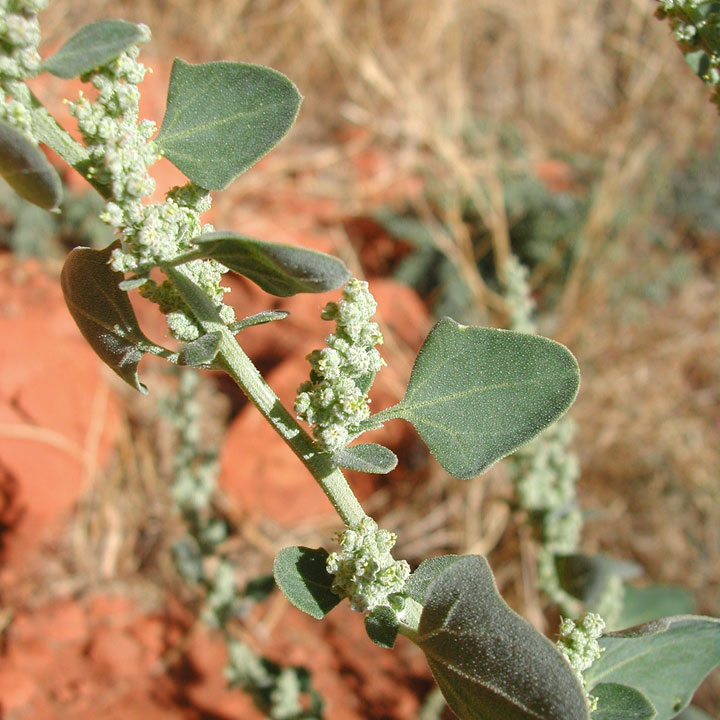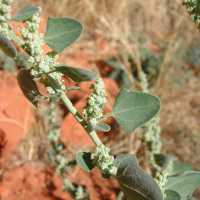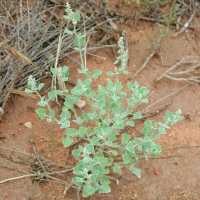Stems erect to spreading, branched from base or simple, 0.6-7.5 dm, farinose. Leaves nonaromatic; petiole 0.5-1 cm; blade broadly triangular to broadly ovate, distal leaves narrowly triangular to narrowly ovate, 1-1.5(-2.3) × 0.5-1.6 cm, thin or thick, base cuneate to subtruncate, margins usually with two basal teeth or lobes, teeth or lobes acute to acuminate, obtuse, or rounded, apex rounded, obtuse, or acute, farinose abaxially. Inflorescences glomerules in terminal and lateral panicles, 3.5-12 × 1-7 cm; glomerules maturing mixed; bracts absent. Flowers: perianth segments 5, distinct nearly to base; lobes ovate, 0.8-1.1 × 0.7-1 mm, apex acute to obtuse, keeled or not, farinose, completely covering fruit at maturity; stamens 5; stigmas 2, 0.2 mm. Utricles ovoid; pericarp nonadherent, smooth. Seeds round, 0.9-1.25 mm diam., margins rounded with a narrow rim; seed coat dark black, wrinkled. 2n = 18.
Duration: Annual
Nativity: Native
Lifeform: Forb/Herb
General: Herbaceous annuals, 6-75 cm; stems erect to spreading, branched profusely from base; herbage farinose.
Leaves: Alternate, petiolate, and farinose on the abaxial (lower) surface; petioles 0.5-1 cm; blades triangular to ovate with a pair of teeth or lobes at the base, 1-2 cm by 0.5-1.5 cm, the distal leaves narrower than basal leaves, thin or thick, apex rounded or acuminate.
Flowers: Inconspicuous, green, farinose, and clustered, the clusters (glomerules) arranged in terminal and axillary panicles, 3-12 cm long; perianth segments 5, the lobes ovate, smooth, completely covering fruit at maturity.
Fruits: Ovoid utricles, with a nonadherent pericarp; seeds smooth, round, 1 mm diameter, dark black and wrinkled, the margins rounded with narrow rim.
Ecology: Found on sandy soils in and disturbed and waste areas from 1,500-8,000 ft (457-2438 m); flowers May-September.
Distribution: Most of western N. Amer. from Saskatchewan to B.C., south through CA and TX to c MEX.
Notes: Chenopodium is a genus of usually weedy annual herbs with simple, alternate leaves, herbage that is commonly farinose (with mealy, or floury hairs) to some degree, and clusters of small green flowers lacking petals, which mature into fruits composed of a single seed wrapped in the persistent calyx. C. incanum is difficult to distinguish in the field from C. fremontii and C. neomexicana; very similar to C. album and C. berlandieri also; its absolutely necessary to have mature fruits to ID this group. Distinguished by being densely farinose throughout, much-branched from the base (C. fremontii branched above); triangular leaves with basal lobes; and smooth seeds that are not honeycombed. Also, the seeds are loose within the pericarp (in C. album and C. berlandieri the pericarp closely hugs the seeds.) Distinguished from C. fremontii by being more diffusely branched from the base, much more farinose throughout the entire plant, and having thicker leaves. Look for it in Chenopodiaceae in older texts; that entire family is now considered to be part of Amaranthaceae.
Ethnobotany: Stem used ceremonially, seeds ground and eaten, young shoots boiled, as were leaves all eaten as greens.
Etymology: Chenopodium is goose foot in Latin, incanum means grayish or hoary.
Synonyms: None
Editor: SBuckley 2010, FSCoburn 2015, AHazelton 2015





